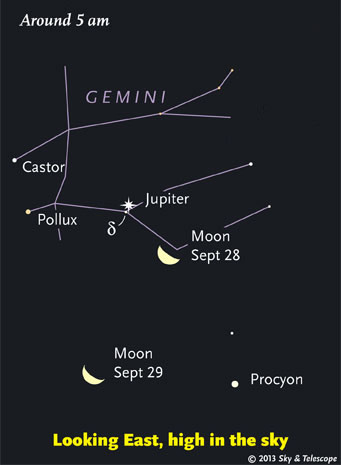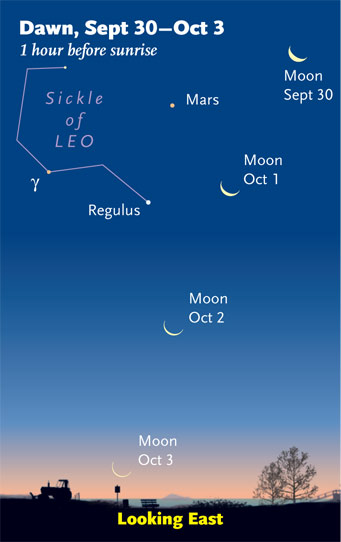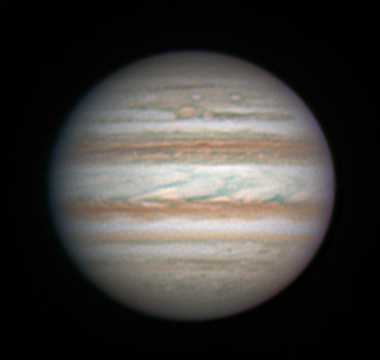
Before dawn, the waning Moon lights the way to Jupiter in the midst of Gemini.
Friday, September 27
Saturday, September 28
Sunday, September 29

Early risers can watch the waning Moon pass Mars and Regulus this week.
Monday, September 30
Tuesday, October 1
Wednesday, October 2
Thursday, October 3
Friday, October 4
Saturday, October 5
Want to become a better amateur astronomer? Learn your way around the constellations. They're the key to locating everything fainter and deeper to hunt with binoculars or a telescope.
This is an outdoor nature hobby. For an easy-to-use constellation guide covering the whole evening sky, use the big monthly map in the center of each issue of Sky & Telescope, the essential guide to astronomy. Or download our free Getting Started in Astronomy booklet (which only has bimonthly maps).

The Pocket Sky Atlas plots 30,796 stars to magnitude 7.6 — which may sound like a lot, but that's less than one star in an entire telescopic field of view, on average. By comparison, Sky Atlas 2000.0 plots 81,312 stars to magnitude 8.5, typically one or two stars per telescopic field. Both atlases include many hundreds of deep-sky targets — galaxies, star clusters, and nebulae — to hunt among the stars.
Sky & Telescope
Once you get a telescope, to put it to good use you'll need a detailed, large-scale sky atlas (set of charts). The standards are the little Pocket Sky Atlas, which shows stars to magnitude 7.6; the larger and deeper Sky Atlas 2000.0 (stars to magnitude 8.5); and once you know your way around, the even larger Uranometria 2000.0 (stars to magnitude 9.75). And read how to use sky charts with a telescope.
You'll also want a good deep-sky guidebook, such as Sue French's Deep-Sky Wonders collection (which includes its own charts), Sky Atlas 2000.0 Companion by Strong and Sinnott, the bigger Night Sky Observer's Guide by Kepple and Sanner, or the beloved if dated Burnham's Celestial Handbook.
Can a computerized telescope replace charts? Not for beginners, I don't think, and not on mounts and tripods that are less than top-quality mechanically (able to point with better than 0.2° repeatability, which means heavy and expensive). As Terence Dickinson and Alan Dyer say in their invaluable Backyard Astronomer's Guide, "A full appreciation of the universe cannot come without developing the skills to find things in the sky and understanding how the sky works. This knowledge comes only by spending time under the stars with star maps in hand."
This Week's Planet Roundup

No, Jupiter's Great Red Spot hasn't suddenly shrunk. That thing above (south of) center is Jupiter's Oval BA, "Red Spot Junior." S&T's Sean Walker took this stacked video image on September 9th at 9:54 UT with a 12.5-inch reflector through poor to fair seeing. He says, "Of particular note is the small red spot following [just right of] Oval BA. It shows up on all of my videos this morning."
S&T: Sean Walker
Mercury (magnitude –0.1) is deep in the glow of sunset. About 30 minutes after sunset, use binoculars to search for it about 20° lower right of Venus and 9° lower right of Saturn.
Venus and fainter Saturn (magnitudes –4.2 and +0.7, respectively) shine low in the west-southwest in evening twilight. Locate Venus far to the lower left of Arcturus. Saturn, much fainter, is 10° to Venus's right on Friday the 27th, and 17° to Venus's right by Friday October 4th.
Mars (magnitude 1.6, in Leo) rises around 3 a.m. and glows due east as dawn begins. Look for it far lower left of bright Jupiter. Below Mars is Regulus, similarly bright and moving closer to it daily. Compare their colors. The gap between them is shrinking: from 10° on the morning of September 28th to 6° on the morning of October 5th.
In a telescope, Mars is still an impossibly tiny 4.4 arcseconds wide.
Jupiter (magnitude –2.2, in central Gemini) rises around midnight and blazes high in the east-southeast by early dawn. About 9° left of it are Castor and Pollux. The magnitude-3.5 star very close to it (less than 0.6° all week) is Delta Geminorum.
Uranus (magnitude 5.7, in Pisces) and Neptune (magnitude 7.8, in Aquarius) are well up toward the southeast by 10 p.m. Finder charts for Uranus and Neptune. See also the October Sky & Telescope, page 50.
All descriptions that relate to your horizon — including the words up, down, right, and left — are written for the world's mid-northern latitudes. Descriptions that also depend on longitude (mainly Moon positions) are for North America. Eastern Daylight Time (EDT) equals Universal Time (also known as UT, UTC, or GMT) minus 4 hours.
Like This Week's Sky at a Glance? Watch our SkyWeek TV short, also playing on PBS.
To be sure to get the current Sky at a Glance, bookmark this URL:
http://SkyandTelescope.com/observing/ataglance?1=1
If pictures fail to load, refresh the page. If they still fail to load, change the 1 at the end of the URL to any other character and try again.
 0
0
Comments
You must be logged in to post a comment.